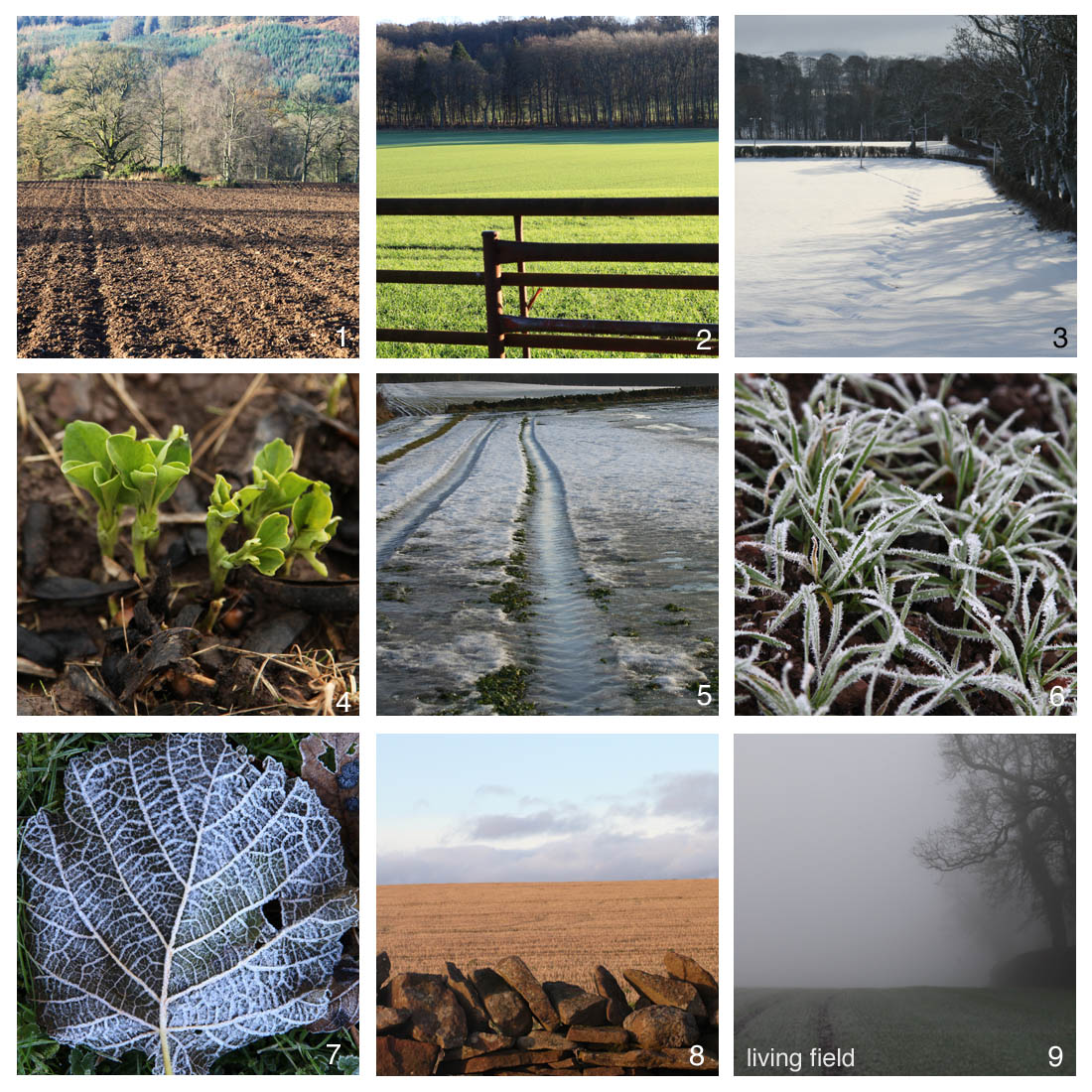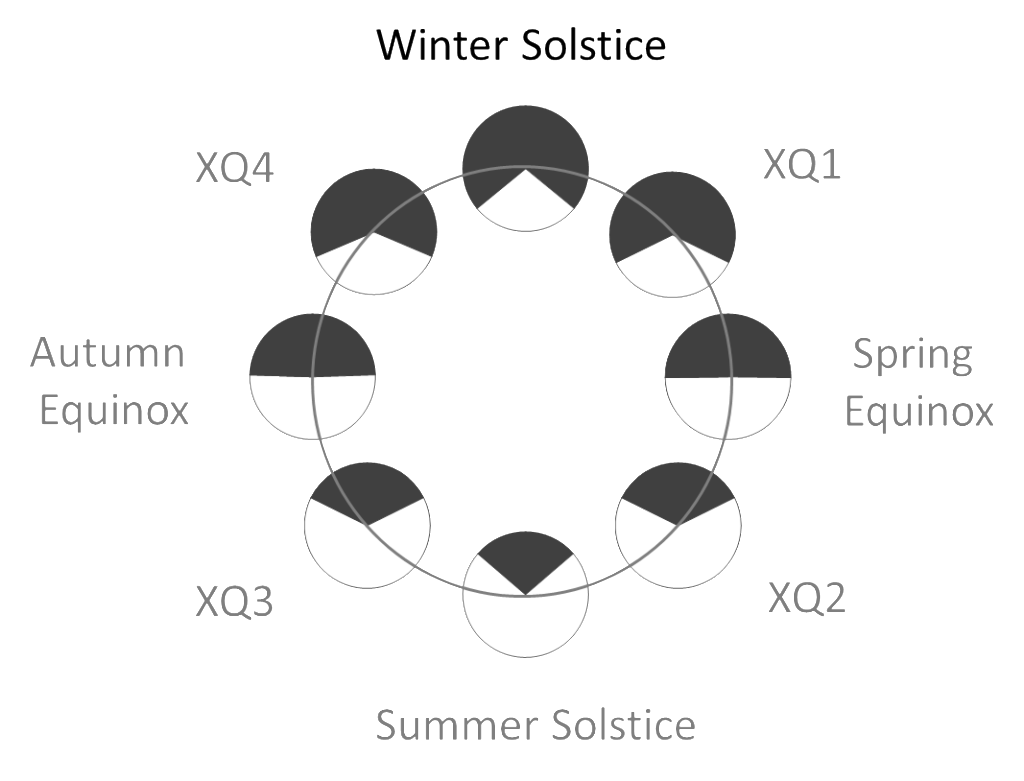The winter solstice is the time of shortest days, lowest sun and least solar energy. The solstice usually occurs on 21 December. The croplands are not yet in the depths of winter: there can be snow and hard frost next to warm days when the air temperature rises. The crops are hardly growing and most wild plants are dormant.

Images around the winter solstice
1 Ploughed field. 2 Green field. 3 Snow field.
4 Shoots of field bean Vicia faba sprouting from last year’s dropped seed. 5 Ice field. 6 Haar-rimed young winter cereal plants.
6 Frosted hazel leaf showing ‘veins’ that carried last year’s water. 7 Stubble field. 8. Haar field.
Haar is a dense sea-mist that can cover the croplands at any time of year. On a cold day in winter it sometimes deposits frozen rime on crops, trees, walls, fences and any other surface. Images are from Angus and Perthshire.
Solar energy and the air’s temperature
The graph shows the location of the winter solstice (WS) on the annual cycles of solar energy and air temperature. The solar cycle, the orange line marked ‘sol’ on the graph, is at its lowest point. The days are shortest around this time, the sun is at its lowest altitude in the sky and is often obscured by cloud. The weather can be bright for a time around the middle of the day, but more commonly there is cloud and sometimes a sea fog, a haar that ‘drips’ ice.

The position and usual date of the winter solstice, WS (Living Field)
Temperature is still declining and has not yet reached its lowest point. On some days it can be over 10 degrees Celsius and on others just below zero. The temperature depends on where the wind is blowing from, warm from the south-east or icy cold from the north. A strong north easterly takes only a few hours to get from Siberia. The direction of the wind depends on the position of weather patterns in the north Atlantic: as they move across Britain and onto mainland Europe, the wind – and temperature – can change by the hour.
[The introduction to The Year and Winter Solstice Revisited explain how the sol-temp graph was derived and give examples of variation with latitude.]
Light and dark
The winter solstice is the darkest point in the year’s cycle. Night is almost three times as long as day.

At latitude 56 N, on 21 December 2015, sunrise is 08.45 and sunset 15.36 (Universal Time).
The crops
There are four states to the arable fields: harvested and ploughed, showing bare soil and no crop; harvested and still in stubble; harvested late summer and sown in autumn with winter crops and now showing rows of green shoots; and a minority, fields of ‘root’ crops and forages, sown earlier and now full and green, some damaged by cold.
The weather is variable – the fields can be open, revealing the greens and browns of crops, soil and stubble; or else covered in sheets of ice or snow, or frozen-drenched in haar.
Of the winter crops, oilseed rape is perhaps the most sensitive; it needs to be sown in late summer ot early autumn, giving it time to get its roots down into the soil and a good canopy of leaf before the winter chill starts to cut it back. Delay in sowing much after late August will bring a yield penalty next summer. Winter barley and winter wheat, and occasionally winter oat, should all be showing bright green rows of emerged shoots, but not yet closed into a complete leaf canopy.
The ploughed and stubble fields are waiting for the spring sowing, three to four months to go.
The tradition
Festivals, events, song , music around the winter solstice
Festivals and events
There are many, this time of year, marking the low point in the sun’s calendar, some ancient or revived from the past, some more recent and building on ancient markings, the traditional customs hanging on, reinvented and sometimes almost disappeared. Here are a few.
- Christmas, celebrating the birth of Jesus in the Christian tradition
- Winter solstice at ancient monuments – sunrise at at Maes Howe, Orkney. See Maes Howe on Solstice day: Historic Environment Scotland’s New online film celebrating the winter solstice on Orkney and also the entries for Maeshowe at Orkneyjar and Canmore.
- The european traditions around St Nicolas (Santa Claus).
- Wassailing, once common and still alive in many parts of England and Wales.
- New Year – Hogmanay in Scotland – riotous celebration or quiet night and early bed (?)
- Oddfellows parade – the only one left, at Newborough in Fife Scotland, New Year’s eve: Fb page Newborough Caledonian Lodge of Oddfellows.
- Community Carolling – especially in Yorkshire and Derbyshire (links below)
- Stonehaven Fireballs late on the evening of 31st: their Fb page and web site.
- And Up Helly Aa in Lerwick, Shetland later in January, for processions, torches and ship-burnings.
Music and song
Great music and song – traditional and written carols, chants and liturgies, the turning of the year (in time and mind).
Cruel winter cuts through like the reaper | The old year lies withered and slain | Like barleycorn who rose from the grave | The new year will rise up again
From the song Snow Falls by John Tams
The record label Free Reed published its box set titled Midwinter: a celebration of the folk music and traditions of Christmas and the Turning of the Year. 2006. Booklet (Nigel Schofield) and 4 CDs by Free Reed. Unrivalled for breadth of coverage. Details at the Free Reed web site.
Community folk carolling, notably in Yorkshire and Derbyshire: start with the web site Village Carols which gives links to carol traditions in various parts of the UK and under the Publications tab lists books and recordings, including The Sheffield Book of Village Carols by Ian Russell (2008, Elphinstone Institute Aberdeen University).
The Mainly Norfolk web site lists a range of carol albums, e.g. A People’s Carol, On this delightful Morn, Hark, Hark! What news, and many others, mainly from Yorkshire, Derbyshire and Nottinghamshire.
John Kirkpatrick (sings, writes songs, plays accordions) has several albums of winter songs – try Wassail! (a traditional celebration of English Midwinter) and Joy and Jubilation (glorious midwinter fare), available through the JK website shop.
Frost and fire – seminal recording of seasonal songs by the Watersons on Topic Records, includes ‘Christmas is now drawing near at hand’, ‘Here we come a wassailing’, ‘The holly bears a berry’ and ‘Herod and the Cock’. Details at the Topic Records web site.
Folk group Melrose Quartet, based in Sheffield: their CD containing carols and songs, The Rudolf Variations, can be bought at their online store.
And a few others: Da Day Dawn: ‘played in Lerwick Shetland before New Year’s Day’ – see Mairi Campbell’s Music for fiddle tune and song (It’s the dawning of the turning of the year….) and ‘Thou shalt’ by Chris Wood “…but your body will suffer at the turning of the year …”, from the album None the Wiser (and see also this blog).
[Last update 30 December 2023…]
